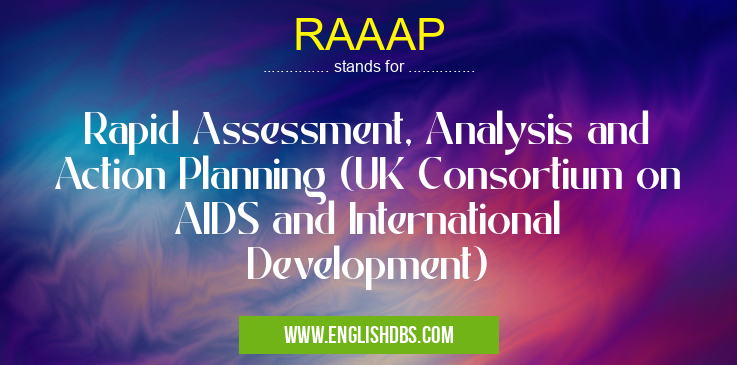What does RAAAP mean in CONSORTIUMS
RAAAP stands for Rapid Assessment, Analysis and Action Planning. It is a framework developed by the UK Consortium on AIDS and International Development (CAID) to guide the rapid assessment of a situation, analysis of the findings, and development of an action plan.

RAAAP meaning in Consortiums in Miscellaneous
RAAAP mostly used in an acronym Consortiums in Category Miscellaneous that means Rapid Assessment, Analysis and Action Planning (UK Consortium on AIDS and International Development)
Shorthand: RAAAP,
Full Form: Rapid Assessment, Analysis and Action Planning (UK Consortium on AIDS and International Development)
For more information of "Rapid Assessment, Analysis and Action Planning (UK Consortium on AIDS and International Development)", see the section below.
Key Features of RAAAP
- Rapid: Designed to be conducted within a short timeframe, typically 2-4 weeks.
- Participatory: Involves stakeholders from various sectors and levels.
- Flexible: Can be tailored to different contexts and project requirements.
- Iterative: Allows for ongoing adjustments based on emerging data and feedback.
Steps in the RAAAP Process
- Assessment: Gathering information on the situation through interviews, surveys, and data collection.
- Analysis: Interpreting and synthesizing the data to identify key issues and root causes.
- Action Planning: Developing a comprehensive plan outlining actions to address the identified issues.
Benefits of Using RAAAP
- Provides a structured approach for rapid and thorough assessment.
- Facilitates stakeholder engagement and consensus building.
- Enables the development of context-specific and evidence-based action plans.
- Contributes to effective and timely interventions.
Applications of RAAAP
RAAAP has been widely used in various contexts, including:
- Health: Assessing health needs, identifying barriers to care, and developing health interventions.
- Development: Evaluating project impact, assessing community needs, and designing sustainable solutions.
- Emergency response: Conducting rapid assessments in disaster zones and developing response plans.
Essential Questions and Answers on Rapid Assessment, Analysis and Action Planning (UK Consortium on AIDS and International Development) in "MISCELLANEOUS»CONSORTIUMS"
What is the purpose of RAAAP?
Rapid Assessment, Analysis and Action Planning (RAAAP) is a methodology developed by the UK Consortium on AIDS and International Development (CAID) to provide health services with a framework for identifying and addressing the needs of key populations most affected by HIV and sexually transmitted infections (STIs).
What are the key components of RAAAP?
RAAAP consists of three main phases: Rapid Assessment, Analysis, and Action Planning. The Rapid Assessment involves gathering data to understand the context, needs, and vulnerabilities of key populations. The Analysis phase helps to identify gaps and prioritize interventions. Finally, the Action Planning phase involves developing and implementing tailored interventions to address the identified needs.
How is RAAAP implemented?
RAAAP is typically implemented through a participatory approach, involving key populations, healthcare providers, and policymakers. The methodology can be used in various settings, including low-resource environments.
What are the benefits of using RAAAP?
RAAAP provides a structured approach to identifying the specific needs of key populations, enabling the development of targeted interventions that are more likely to be effective. It also promotes collaboration and engagement between different stakeholders, fostering a sense of ownership and sustainability.
How can RAAAP be adapted to different contexts?
RAAAP is designed to be flexible and can be adapted to the specific needs of different communities and countries. The methodology provides a framework that can be tailored to address local priorities and resource constraints.
Final Words: RAAAP is a valuable tool for conducting rapid assessments, analyzing findings, and developing action plans in a variety of settings. Its participatory, flexible, and iterative approach ensures that interventions are context-specific, evidence-based, and responsive to the needs of stakeholders.
